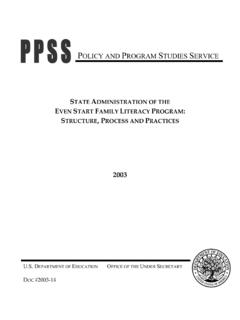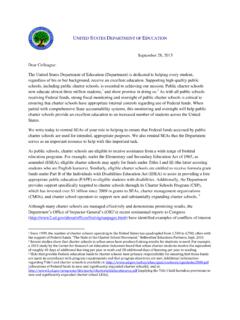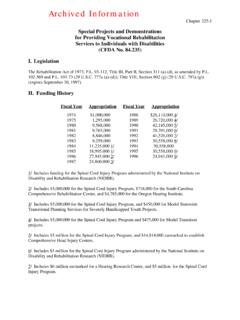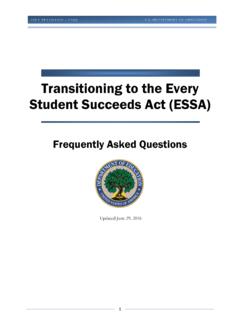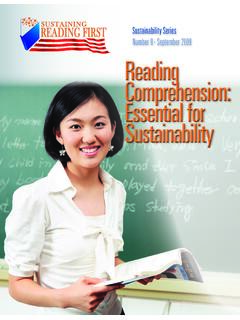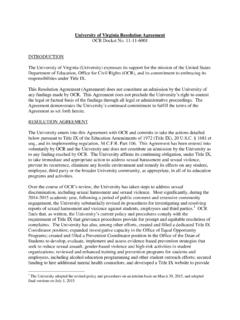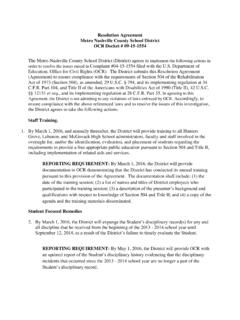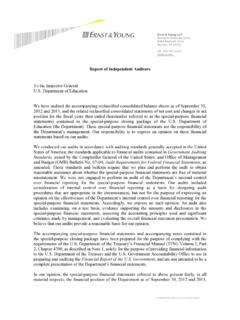Transcription of ED COVID-19 HANDBOOK
1 Volume 1 2021 ED COVID-19 HANDBOOK Strategies for Safely Reopening Elementary and Secondary Schools OPEPD-IO-21-01 Department of Education Dr. Miguel A. Cardona Secretary of Education Office of Planning, Evaluation and Policy Development Donna M. Harris-Aikens Acting Assistant Secretary Initially released in February 2021; updated April 2021; updated August 2021 The updates included in this Volume of the ED COVID-19 HANDBOOK are based on the most recent Centers for Disease Control and Prevention (CDC) Guidance issued as of August 17, 2021. For the most recent CDC guidance issued after the release of this Volume and how to consider the strategies included in this resource within the context of the most up to date guidance please visit: Summary of Changes in August 2021 Update: Added language on the importance of offering in-person learning, regardless of whether all of the prevention strategies identified in this document can be implemented at the school.
2 Revised to emphasize the COVID-19 prevention strategies most important for in-person learning for K-12 schools. Updated to reflect that vaccination is the leading prevention strategy to end the COVID-19 pandemic and reflect that promoting vaccination can help schools safely return to in-person learning as well as extracurricular activities and sports. Updated to emphasize the need for localities to monitor community transmission, vaccination coverage, screening testing, and occurrence of outbreaks to guide decisions on the level of layered prevention strategies. Updated to align with guidance for fully vaccinated people and most recent mask guidance at the time of publication, which indicates that all people should wear masks in K-12 schools, regardless of vaccination status.
3 This report is in the public domain. Authorization to reproduce it in whole or in part is granted. While permission to reprint this publication is not necessary, the citation should be Department of Education, Office of Planning, Evaluation and Policy Development, ED COVID-19 HANDBOOK , Volume 1: Strategies for Safely Reopening Elementary and Secondary Schools, Washington, DC, 2021. This report is available on the Department s website at Availability of Alternate Formats On request, this publication is available in alternate formats, such as Braille or large print. For more information, please contact the Department s Alternate Format Center at 202-260-0818 or via e-mail at Notice to Limited English Proficient Persons If you have difficulty understanding English, you may request language assistance services for Department information that is available to the public.
4 These language assistance services are available free of charge. If you need more information about interpretation or translation services, please call 1-800-USA-LEARN (1-800- 872-5327) (TTY: 1-800-877-8339), email us at or write to Department of Education, Information Resource Center, 400 Maryland Ave., SW, Washington, DC 20202. Contents Introduction .. 1 Summary of CDC Operational Strategies and Steps for Safe School Reopening .. 3 Safe Practices for In-Person Learning .. 8 Promoting Vaccination .. 8 Masking Practices .. 9 Physical Distancing Practices .. 11 Cohorting/Podding and Staffing Considerations for Physical Distancing.
5 15 Transportation Considerations .. 17 Staying Home When Sick and Getting 18 Handwashing and Respiratory Etiquette .. 19 Safety Considerations Related to Music, Arts, and Athletics Programs .. 19 Supporting Ongoing Engagement with Educators, Families, and the School Community .. 22 1 Introduction President Biden committed to seeking the necessary resources to support the safe reopening and continued operation of schools. As stated in Executive Order 14000, Supporting the Reopening and Continuing Operation of Schools and Early Childhood Education Providers, every student in America deserves a high-quality education in a safe environment.
6 The Biden-Harris Administration believes strongly that returning to in-person learning as soon as possible is essential for all students and families, and has taken decisive action to support the safe reopening of schools for in-person instruction and to address the needs of students. In particular, updated guidance reflects the need for all students (age 2 and older), educators, staff, and visitors to K-12 schools to wear masks consistently and correctly, regardless of vaccination status. The Administration recognizes the unique challenges students in underserved communities face, including students from low-income backgrounds, students of color, LGBTQI+ students, English learners, students with disabilities, American Indian and Alaska Native students, students who are migratory, students in foster care, students in correctional facilities, and students experiencing homelessness.
7 Such students are less likely to have access to the broadband, resources, and other supports required to participate in high-quality remote education. They also are more likely to rely on key school-supported resources, such as food programs, special education and related services, counseling, and after-school programs to meet basic developmental needs. For parents and guardians/caregivers (referenced collectively hereafter in this volume as parents ) who have less-flexible jobs, staying at home to provide care for their children and aid with remote learning might be impracticable or impossible. While the pandemic has impacted all communities and students, it has had a particularly devastating impact on communities and people of color, as described in the Department s Office for Civil Rights report Education in a Pandemic: The Disparate Impacts of COVID-19 on America s Students.
8 To fully reopen schools safely for in-person learning, schools need strong state and local public health measures that everyone follows. Achieving high levels of COVID-19 vaccination among eligible students as well as teachers, staff, and household members is one of the most critical strategies to help schools safely resume full operations. Vaccination is the leading public health prevention strategy to end the COVID-19 pandemic. People who are fully vaccinated against COVID-19 are at low risk of symptomatic or severe infection. In general, people are considered to be fully vaccinated two weeks after their second dose in a two-dose series (such as the Pfizer or Moderna vaccines) or two weeks after a single-dose vaccine (such as Johnson and Johnson s Janssen vaccine).
9 People 12 years and older are eligible for COVID-19 vaccination. The Centers for Disease Control and Prevention (CDC) also recommends that individuals who are moderately to severely immunocompromised and who have received two mRNA COVID-19 vaccine doses receive a third dose of mRNA COVID-19 vaccine at least 28 days after their second dose. 2 Schools can promote vaccinations among teachers, staff, families, and students by providing information about COVID-19 vaccination, encouraging vaccine trust and confidence, and establishing supportive policies and practices that make getting vaccinated as easy and convenient as possible. The President has called on school districts nationwide to host at least one pop-up vaccination clinic over the coming weeks.
10 To address this call to action, schools should, for example, consider partnering with state or local health authorities to serve as COVID-19 vaccination sites, and work with local healthcare professionals and organizations, including school-based health centers. Offering vaccines on-site before, during, and after the school day and during school events can potentially decrease barriers to getting vaccinated against COVID-19 . Additional information can be found in the Back to School toolkit and the Guide to On-Site Vaccination Clinics for School. In addition, the Administration is directing pharmacies in the Federal Retail Pharmacy Program to prioritize vaccinations for youth and to work with school districts across the country to host vaccination clinics at schools and colleges.
